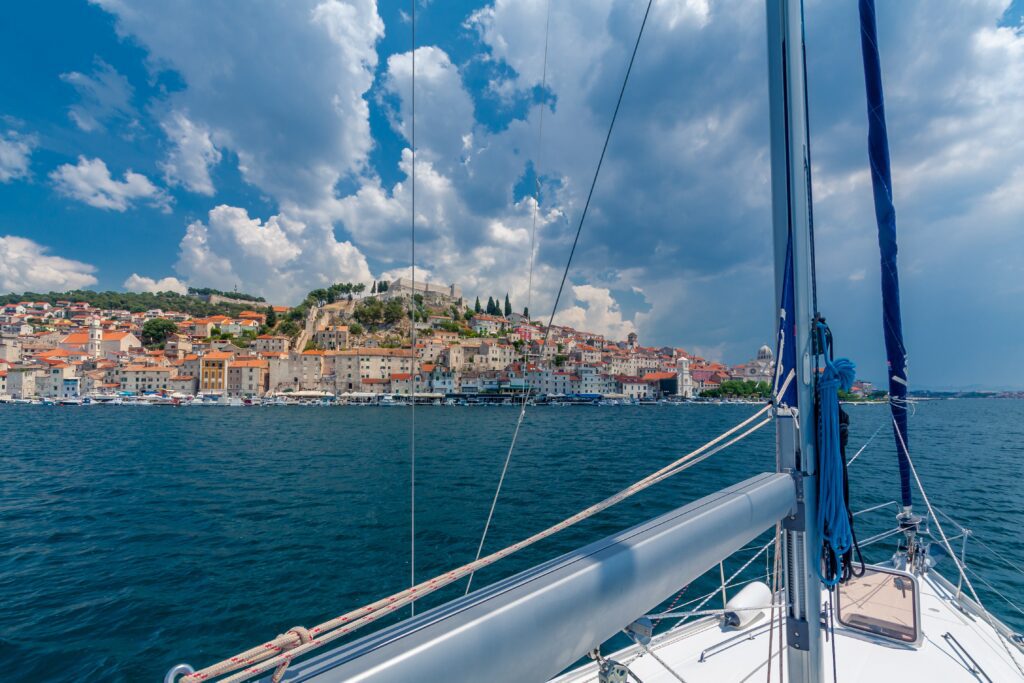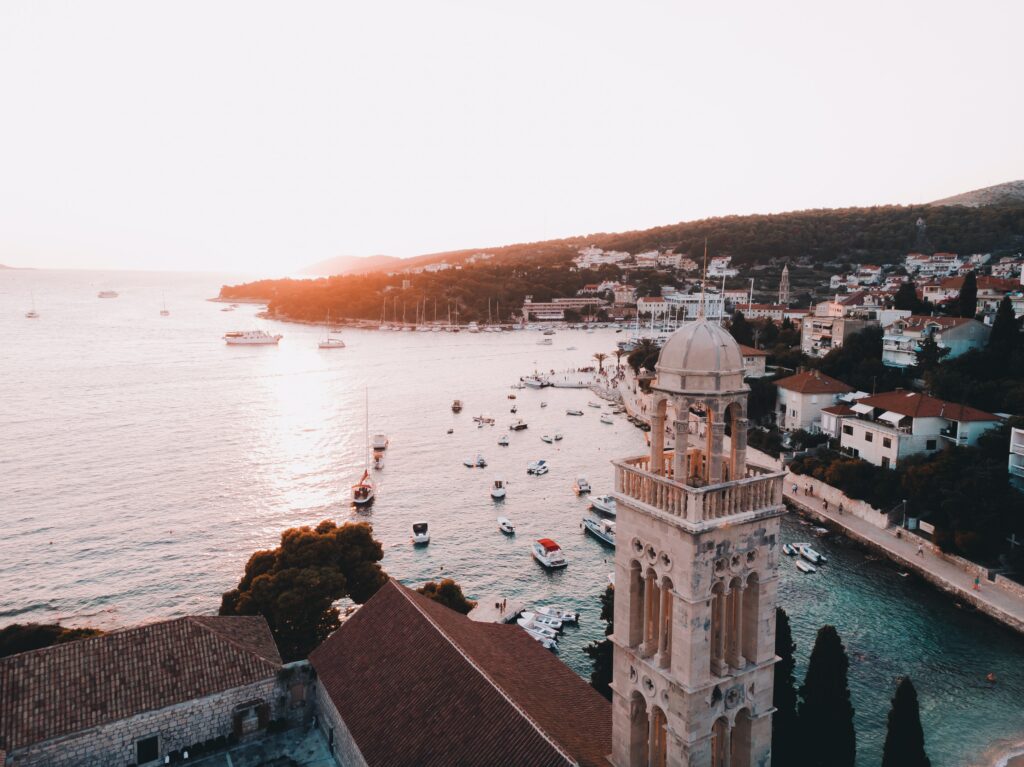With Croatia already a popular destination for interrailers, it would be a shame to miss out on the opportunity to visit some of the country’s islands. There are over 1000 to choose from, but here we’ve compiled a list of five that we’d recommend.
There are plenty of options of ferry fleets to use to travel to the islands, however, the Jadrolinija ferries are the most widespread. Do double check which are the best options for your travelling, as prices and routes vary across the multiple organisations.
Without further ado, lets dive into some of the best Croatian islands to visit during your interrailing adventures!

Brač
First up on our list is Brač, which lies only 5km away from the mainland and is accessible from the popular town of Split. In fact, it is so close to Split that some of the white limestone from the island was used in the construction of Split’s 4th-century Diocletian Palace. On the island, the villages of Bol and Supeta are firm favourites amongst visitors, and hold a rich history, given the many administrative changes that have happened. Over the years, the island has been ruled over by Slavs, Venetians, and Hungarians, to name a few, with each empire making it mark on the culture and appearance of the island.
Be sure to check out the Blaca Hermitage and Vidova Gora Mountain while you spend some time on the island, and definitely don’t forget Zlatni Rat Beach! This stunning white pebble beach stretches out southwards into the Hvar Channel, and the spit of land also home to a Mediterranean pine grove with a Roman villa that used to include a swimming pool hidden amongst the trees. As with many of the Croatian islands we mention in this article, wine and olives make up an important part of the agricultural economy of the island, with plenty of chance to try them in the restaurants and bars on Brač itself.

If you choose to stay on the northern coast of Brač, we’d recommend staying in the Funky Donkey Hostel, which is just a ten minute walk to the main ferry port and streets of Supeta. With a laundry service, complimentary breakfast and even a resident golden retriever, what more could you ask for! If the southern side of the island and Bol is more to your liking, check out Hostel Bol. This hostel in less than a hundred metres away from the sea and has an indoor swimming pool too, so it’s the perfect place to stay while you’re on the island.
Hvar
Hvar is one of the most popular of the Croatian islands for tourists, so it would be criminal to miss it off of our list. It is well-known for its party scene, and has welcomed the likes of Prince Harry, Beyonce, Jay-Z and George Clooney in the past. If a good party is what you’re after, Carpe Diem, and Falko Bar would be our recommendations, as the popular Hula Hula can be overpriced and too busy. However, in the next section, we’ll give you an idea of what else this diverse and wonderful island has to offer aside from a good night out.
Hvar Town grew to prominence as a Venetian naval base and has since become the central hub of the island. Whilst you’re in the town, take a trip to one of the local forts: the 13th-century Spanjola Fortress provided shelter and refuge for the locals during the 1571 Turkish attack and now houses a museum of artefacts and treasures from the area; alternatively, or as well (!) explore the Tvrdava Napoleonic Fortress that is just 4km from Hvar Town. Both are perfect if you want to catch some stunning views of the nearby town and the neighbouring islands across the water, and we’d encourage you to pack a picnic and head up to watch the sunset at the end of the day.
St Stephen’s Square can also be found in Hvar Town and it is one of the most important places on the island for locals. The three-nave St Stephen’s Cathedral, with its 15th-century choir stalls and stunning bell tower sit in the corner of the square, complemented by the Venetian and Renaissance architecture of the surroundings, so be sure to take a moment to enjoy the beauty of this location, and the atmosphere of the oldest square in Dalmatia. The Arsenal, which is often described as one of the most recognisable buildings of the island was once a storage and service facility for Venetian ships, and nowadays hosts exhibitions in a gallery space, and houses what is the oldest communal theatre in Europe.

If you want to venture further afield to some of the lesser-known corners of the island, Stari Grad is a great place to start. With its white stone streets providing the perfect backdrop for bright pink bougainvillea plants, you can discover historic churches amongst the archways, and people often say renting a bike is a fantastic way to explore the nearby Stari Grad Plain, a UNESCO World Heritage Site given the insight it offers to Greek agricultural systems. Stari Grad is also directly accessible from Split as Jadrolinija runs seven journeys a day along this route – it is also worth bearing this journey in mind if the Hvar-Split ferry is fully booked, as Stari Grad is just a short bus ride away from Hvar.
Hvar is home to some culinary excellence, particularly the seafood, and there is even a saying in the area that fish should swim three times: once in the ocean, then in oil, and finally in wine after you’ve eaten it! This is certainly possible whilst on Hvar, and the local vineyards and olive groves definitely help. After you’ve tucked in to some fish, why not give lavender ice cream, or one of the local treats known as ‘Hvar Cake’ a go? Hvar Cake is a sweet and spicy dough cooked in olive oil, and we hear that Nonica, a little café near the ferry terminal to Split, is the place to go to find some.
There are countless exciting things to explore on Hvar, so it’s worth staying on the island for a few days in order to make the most of what’s there. Some of the best hostels are Green Lizard, which is a mere five minute walk from the ferry terminal, Hvar Out, which is super close to Carpe Diem if you’re looking for a hostel near the nightlife, and The White Rabbit, which is a hostel run by travellers for travellers so they’ve got everything covered!
Korčula
Third on our list is Korčula – this island is slightly less well-known, but is rich in history, culture, beauty and charm. Korčula Town is fondly described as “Little Dubrovnik”, thanks to the medieval squares, churches, palaces and houses. There is plenty to get involved with during the summer months, from art exhibitions to folklore evenings, experience culture on the island won’t be hard! One of the prides of the local people is the Morseka dance, which involves the performers taking part in a mock battle over the fate of a veiled young woman, complete with elaborate costumes and swords! July 29th is the perfect opportunity to witness this as it is St Theodore’s Day, in honour of the patron saint of Korčula Town.
A similar dance, the Kumpanija, takes place in the town of Vela Luka, which is on the western side of the island, nestled in a bay with many coves. Vela Luka is the sunniest place in the whole of the Adriatic, with 2671 sunshine hours a year, and is also the warmest place in the Mediterranean. It is also home to one of the most important prehistoric cave dwellings in Europe, Vela Spila, which demonstrates existence of human life in the region 20,000 years ago.
While on Korčula, we’d suggest checking in at the Dragan’s Den Hostel – this well-established hostel holds bonfires each night and also runs shuttles to the Plitvice Lakes National Park, Croatia’s oldest and largest national park.
Otok Susak
The islands we’ve covered so far in this article are relatively highly-populated, but if you’re looking for a true escape from the hustle and bustle of life, then Otok Susak is the island for you. With only 150 permanent residents, this Croatian island is where to head for tranquillity and pristine landscapes. Walking and cycling around the island are your only options, with no cars allowed on the island, along with limited tourist facilites, so you can dive deep into Croatian island living. The sandy and shallow waters of Spiaza beach and Bok beach are perfect for sunbathing and swimming, and a walk up to the lighthouse, that sits at the highest point of the island, will take you past an abandoned 20th-century military post, giving you an insight into the island’s story. As the five-bedroom Hotel Sansegus is the only hotel on the island, it’s also worth exploring the private accommodation options that are on offer, but we’re sure that Otok Susak is perfect for interrailers searching for seclusion and peace. You’ll need to head over to Zadar, rather than Split, to catch the ferry to Otok Susak, which is accessible by train and bus from the Croatian capital of Zagreb, but it is certainly worth the trip.
Dugi Otok
Similar to Otok Susak, Dugi Otok is another Croatian island that is off the beaten track. It is perfect to do as a day trip from Zadar on the mainland. Dugi Otok, literally meaning ‘long island’ can lay claim to one of Croatia’s finest sandy beaches: Saharun Beach. This near empty beach feels like a piece of the Caribbean in the Adriatic with its fine sand and crystal clear blue waters and is definitely worth a visit. There are opportunities to go snorkelling, kayaking and fishing on the island, with the chance to see dolphins, crabs, sea urchins, coral and sponges, if you’re lucky! Dugi Otok is also home to the Telascica Nature Park and Lake Mir, which is a saltwater lake that is connected to the sea through underwater channels. It has a temperature range of 5 degrees to 33 degrees Celsius during the course of the year, making it warmer than the sea in the summer and colder in the winter, so if you venture to the lake in the summer, don’t forget your swimming costume.
How to reach the ports on the mainland by train
All of the islands we’ve mentioned are accessible from either Split or Zadar, which luckily for the interrailer both have train stations! Jump on a train to either of the port locations from Zagreb, and sit back and relax. Having said this, we should mention that even though the journey to the destination certainly makes up part of the adventure, if you’re pressed for time, consider making use of the Croatian buses to reach Zadar as they can be quicker than the trains to the town.